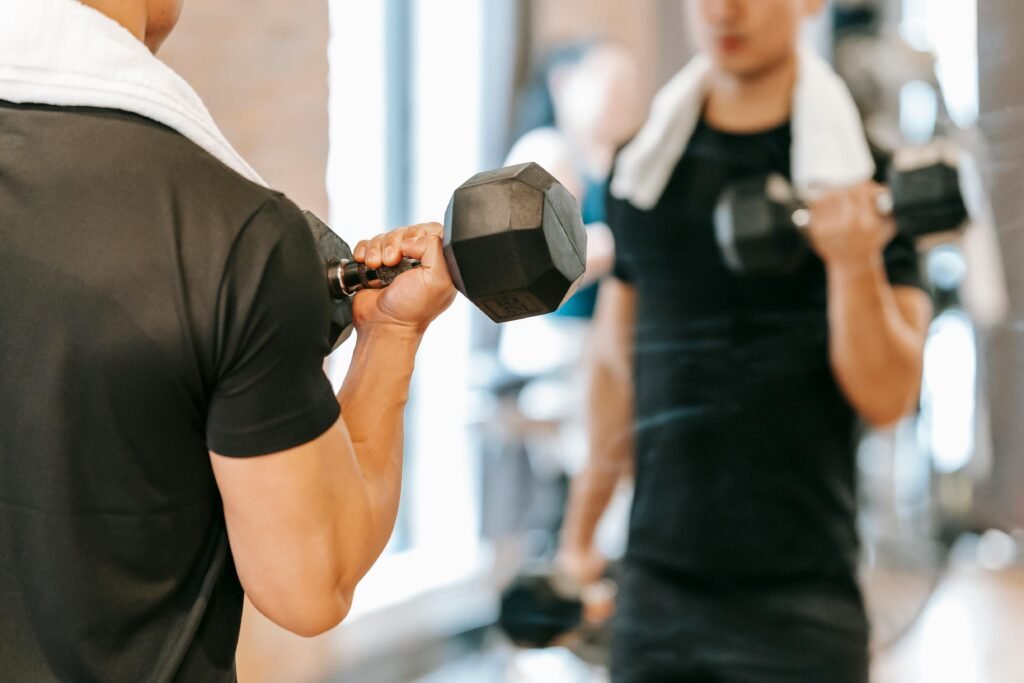Starting a strength workout at home is an excellent way to improve your fitness, boost your mental health, and build a consistent exercise routine. Whether you’re new to working out or transitioning from the gym to a home setup, this guide will help you get started on your strength training journey.

1. Set Clear Goals for starting workout at home
Before you dive into your workout routine, it’s essential to establish what you want to achieve. Your goals might include:
- Building muscle mass
- Losing weight
- Improving overall fitness
- Enhancing specific body parts (e.g., legs, arms, core)
Having clear goals will help you stay motivated and choose the right exercises for your needs.
2. Create a Dedicated Workout Space
Designate a specific area in your home where you can comfortably perform your workouts. This space should be:
- Spacious enough for you to move freely
- Equipped with necessary tools (like a yoga mat, weights, and resistance bands)
- Free from distractions
3. Gather Essential Equipment
You don’t need a lot of fancy equipment to start strength training at home. Some basic items include:
- Dumbbells: Adjustable ones are versatile and space-saving.
- Resistance Bands: Great for adding resistance without heavy weights.
- Yoga Mat: Provides comfort for floor exercises.
- Stability Ball: Useful for core workouts and improving balance.
- Kettlebells: Ideal for a variety of dynamic exercises.
4. Learn Proper Form
Proper form is crucial to prevent injuries and maximize the effectiveness of your workouts. Here’s how to ensure you’re doing exercises correctly:
- Watch Tutorials: There are plenty of online resources with detailed instructions.
- Start Light: Begin with lighter weights to practice your form before increasing the load.
- Mirror Feedback: Use a mirror to check your posture and alignment during exercises.
5. Plan Your Routine
A well-rounded strength training routine includes exercises for all major muscle groups. Here’s a simple weekly plan to get you started:
Day 1: Upper Body
- Push-Ups
- Dumbbell Bench Press
- Dumbbell Rows
- Bicep Curls
- Tricep Dips
Day 2: Lower Body
- Squats
- Lunges
- Deadlifts
- Calf Raises
- Glute Bridges
Day 3: Core
- Planks
- Russian Twists
- Bicycle Crunches
- Leg Raises
- Mountain Climbers
Day 4: Rest or Active Recovery
Day 5: Full Body
- Burpees
- Kettlebell Swings
- Jump Squats
- Renegade Rows
- Dead Bugs
Day 6: Cardio or Light Activity
- Jogging
- Cycling
- Swimming
Day 7: Rest
6. Warm Up and Cool Down
Always start your workouts with a warm-up to prepare your muscles and reduce the risk of injury. A good warm-up might include:
- 5-10 minutes of light cardio (e.g., jogging in place)
- Dynamic stretches (e.g., arm circles, leg swings)
Similarly, end each session with a cool-down to aid recovery. This should include:
- 5-10 minutes of light cardio (e.g., walking)
- Static stretching (e.g., hamstring stretch, chest stretch)
7. Track Your Progress
Keeping track of your workouts helps you see your improvements and stay motivated. You can:
- Journal: Write down your exercises, sets, reps, and weights.
- Apps: Use fitness apps that allow you to log your workouts and track your progress.
- Photos: Take periodic photos to visually document your changes.
8. Stay Consistent and Adjust
Consistency is key to seeing results from your strength training. Stick to your routine and gradually increase the intensity as you get stronger. Don’t be afraid to modify exercises or routines to keep things challenging and interesting.
9. Listen to Your Body
Pay attention to how your body feels during and after workouts. If you experience pain (beyond normal muscle soreness), it may indicate improper form or overtraining. Give yourself rest days and consult a professional if needed.
10. Keep Learning
Fitness is a journey, and there’s always more to learn. Continue exploring new exercises, techniques, and routines to keep your workouts fresh and effective. Online fitness communities, classes, and resources can provide inspiration and support.
Conclusion
Starting a strength workout at home especially full body strength workout is a rewarding endeavor that can lead to significant improvements in your physical and mental well-being. Most importantly you need to know that which body part you need to focus during strength workout. By setting clear goals, creating a dedicated space, learning proper form, and staying consistent, you’ll be well on your way to building a stronger, healthier you. Happy lifting!



